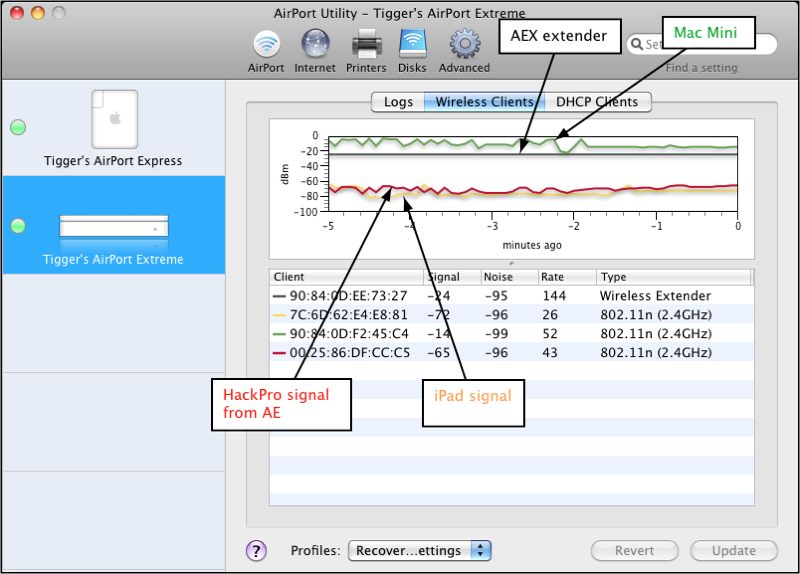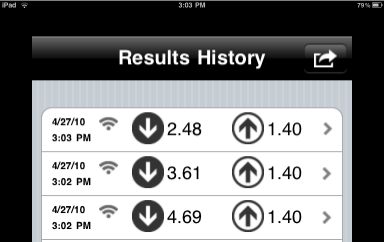Some oddness.
I delved a little deeper into the wifi signal strength in the iPad, following up on my earlier notes which disclose wildly varying broadband speeds as measured from the iPad.
I haven’t quite got to the bottom of it, but there is something fishy going on.
First, a note on my home wifi setup.
- Broadband is provided by an AT&T Uverse modem connected with Ethernet cable to an Airport Extreme (AE) running 802.11n at 2.4gHz. Mine is the version previous to the current dual band one.
- My Mac Mini for the TV sits right below the AE. It is connected to broadband wirelessly.
- My office is 30 feet and two walls away and houses my HackPro with a wireless card emulating Airport functionality.
- I have an Airport Express (AEX) set up as a range extender four feet from the HackPro, boosting the AE’s 802.11n at 2.4gHz. Mine is the current 802.11n version.
- The iPad is, of course, all over the place.
Now take a look at this signal strength chart generated using Airport Utility at the HackPro’s location:

Wifi signal strengths as seen from the HackPro
As you can see the Mac Mini (green line) has the strongest signal, as well it should as it sits right below the AE.
The HackPro gets a weak and fluctuating signal (red line) from the AE (32% of max) but once the AEX is added as a range extender the signal is strong and steady (55% of max – black line). The AEX is a fine complement to a device in a weak wifi location, broadcasting a powerful wifi signal.
But it’s the iPad’s behavior which is puzzling. The iPad’s wifi antenna sits right behind the radio-transparent apple logo in the center of the iPad’s otherwise aluminum back. Right around where I have placed the iPad arrow pointer on the graph, above, I had moved the iPad so that its Apple logo (antenna) was literally touching the AEX’s casing. The wifi signal seen by the iPad dropped some 12 dB (yellow line). By contrast, look at the signal at the iPad on the right hand side of the graph, when I had removed the iPad to a location where it was separated by a wall from both the AE and the AEX. The signal is much stronger and steadier.
This suggests that the iPad’s wifi reception is overloading its wifi circuitry.
By way of follow up I tested the iPad using the Speedtest.net app in three locations:

The three readings reflect:
- iPad on top of the AEX (2.48 down/1.40 up)
- iPad on top of the AE (3.61/1.40)
- iPad 10 feet and one wall away from the AE and 10 feet and one wall away from the AEX (4.69/1.40)
So the closer the iPad is to a wifi signal, the slower it gets! And it’s slowest on top of the AEX which seems to send a more powerful signal than the AE.
As one final test I took readings with the iPad 30 feet and one floor distant from both the AE and AEX. And guess what? I got the highest speeds of all, 5.31 down and 1.41 up, respectively!
So what is called for, it seems, is for Apple to revise its software to reduce the iPad’s antenna signal transmitted to its circuitry when the iPad is very close to a wifi source. The result will be higher speeds. Whether for surfing or sending photographs, you cannot have enough speed. And you can’t be too rich or too thin either, both challenges to the average American at the time of writing.